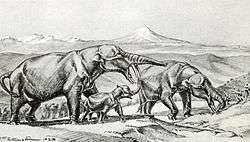Rhynchotherium
| Rhynchotherium Temporal range: Miocene–Pliocene | |
|---|---|
 | |
| Restoration | |
| Scientific classification | |
| Kingdom: | Animalia |
| Phylum: | Chordata |
| Class: | Mammalia |
| Order: | Proboscidea |
| Family: | †Gomphotheriidae |
| Genus: | †Rhynchotherium Falconer, 1868 |
| Species | |
| |
Rhynchotherium is an extinct genus of proboscidea endemic to North America and Central America during the Miocene through Pliocene from 13.650—3.6 Ma, living for approximately 10 million years.[1]
This gomphothere had two tusks and may have evolved from Gomphotherium.[2]
Taxonomy
Rhynchotherium was first described in 1868 on the basis of a lower jaw from the Miocene of Tlaxcala, Mexico.[3] Later, the type species epithet R. tlascalae was erected for the jaw by Henry Fairfield Osborn in 1918. In 1921, a gomphothere skull from the Mt. Eden area of southern California was described as a subspecies of Trilophodon shepardi (a now-defunct combination for Mastodon shepardi), T. s. edensis,[4] but was subsequently reassigned to Rhynchotherium.[5] Other species subsequently assigned to Rhynchotherium included R. falconeri,[6] R. paredensis, R. browni,[7] and R. simpsoni.[8]
Lucas and Morgan (2008) reviewed the taxonomy of Rhynchotherium and concluded that only R. edensis, R. falconeri, R. paredensis, R. browni, and R. simpsoni could be confidently referred to Rhynchotherium.[9] Because the genotype of Rhynchotherium is referable to Gomphotherium, the ICZN was petitioned to conserve the genus by designating R. falconeri as the type species,[10] which it did.[11]

Misassigned species
- Mastodon shepardi Leidy, 1871
- Mastodon euhypodon Cope, 1884 - likely a species of Gomphotherium[9]
- Tetrabelodon brevidens Cope, 1889
- Dibelodon praecursor Cope, 1893
- Rhynchotherium rectidens Osborn, 1923
- Aybelodon hondurensis Frick, 1933
- Blickotherium blicki Frick, 1933
- Rhynchotherium anguirivale Osborn, 1936
References
- ↑ Paleobiology database: Rhynchotherium basic info
- ↑ Arroyo-Cabrales, J.; Polaco, O. J.; Laurito, C.; Johnson, E.; Alberdi, M. T.; Zamora, A. L. V. (2007). "The proboscideans (Mammalia) from Mesoamerica". Quaternary International. Elsevier. 169-170: 17–23. doi:10.1016/j.quaint.2006.12.017. Retrieved 2008-07-28.
- ↑ FALCONER, H. (1868): Paleontological Memoirs. Volume II: 74 –75; London (Hardwicke).
- ↑ C. Frick. 1921. Extinct vertebrate faunas of the badlands of Bautista Creek and San Timoteo Canyon, southern California. University of California Publications in Geology 12(5):277-424
- ↑ FRICK, C. (1933): New Remains of Trilophodont-Tetralophodont mastodons. – Bulletin American Museum of Natural History, 59: 505 – 652.
- ↑ OSBORN, H. F. (1923): New subfamily, generic and specific stages in the evolution of the proboscidea. – American Museum Novitates, 99: 1– 4.
- ↑ OSBORN, H. F. (1936): Proboscidea: a monograph of the discovery, evolution, migration, and extinction of the mastodonts and elephants of the world, vol. 1: Moeritherioidea, Deinotherioidea, Mastodontoidea. New York (The American Museum Press).
- ↑ OLSEN, S. J. (1957): A new beak-jawed mastodont from Florida. – Journal of the Palaeontological Society of India, 2: 131–135.
- 1 2 LUCAS, S.G. & MORGAN, G.S., 2008. Taxonomy of Rhynchotherium (Mammalia, Proboscidea) from the Miocene-Pliocene of North America.- New Mex. Mus. Nat. Hist. Sci. Bull. 44: 71-87.
- ↑ LUCAS, S. G. (2010): Rhynchotherium Falconer, 1868 (Mammalia; Proboscidea): proposed conservation of usage by designation of Rhynchotherium falconeri OSBORN, 1923 as the type species. – Bulletin of Zoological Nomenclature, 67: 158 –162.
- ↑ http://iczn.org/content/opinion-2295-case-3515-rhynchotherium-falconer-1868-mammalia-proboscidea-usage-conserved-des